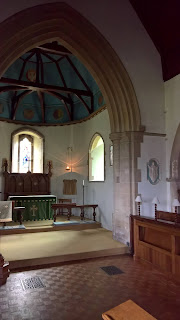 |
| The smoking den |
A pub which we suspected of not having been under present management for that long, management which had put a lot of effort into upgrading the place. Which included the fine smoking den illustrated above, with a good supply of both summer flowers and ashtrays. Plus, a derelict house left.
Inside, a cheerful lady of middle years happy to talk about her fine (and friendly) red setter in particular and the world in general, all afternoon if we had cared to stop that long. Unusually, a lady with a clear preference for listening to talk on the radio while doing something else, like ironing or riding in the car, than to music. She also remembered about the 'Clitheroe Kid', now to be heard on some heritage channel in the afternoons. Sadly I was on the fizzy water, so was not able to savour the atmosphere in the way of years gone by.
Instead, down the road to inspect the church of Saints Cosmas and Damian, a genuinely old foundation, but substantially rebuilt in the mid nineteenth century. With the dedication to the Saints Cosmas and Damian, a pair of twin doctors from Syria, this being both very topical and very unusual, in this country, at least according to Wikipedia. A place with what seemed like a very large graveyard.
 |
| Graveyard one |
 |
| Syrupy sentiment |
The world is vain and full of pain,
With cares and troubles sore,
But they are blest who are at rest,
With Christ for evermore.
Presumably there is a technical terms for this particular sort of rhythm and rhyme. Quite handsome inside, including an unusual apse, presumably more or less following the shape of the Norman original, even if the fabric is substantially new.
 |
| Apse |
 |
| South aisle |
 |
| Library |
And so onto the Ditchling Museum of Art and Craft, a tastefully converted clutch of farm buildings set in a large and walled and grassed yard of uncertain origins. A museum which contained a modest amount of the arts and crafts for which Ditchling was famous, including some stuff by or to do with Gill. But a lot of space was given over to the work of a Californian nun, one Corita Kent, to be found at reference 3. I did not care for her work, nor do I care for ladies who want to be both nuns and celebrities - not that, as an atheist, it is really any of my business. But more interesting than her work were facsimiles (I would not have thought they were the real thing) of a correspondence between the Catholic authorities of Los Angeles and her nominal mother superior. All very tortured, with the authorities taking what is more or less my position, that is to say that sister Corita was not being very godly. Far too full of herself. Not showing proper humility before Jesus. Upsetting the faithful with her unusual art.
Of still greater interest was an ancient hand press, a great lump of nineteenth century cast iron and machinery from Stanhope. Plus various bits and pieces to go with it, including the stone (actual a lump of iron) on which one assembled the type in its frame.
 |
| Wrong press |
Next stop St. Mary's church, another church of ancient foundation and large graveyard. The church did not seem as lively at that at Hassocks inside, but we did spend some time looking for Gill inscriptions outside - such being his stock in trade, his bread and butter as it were, and I don't suppose he would have scrupled to do a stone for the Prots, despite being a rather zealous convert to the other lot himself. But the nearest we came was a commemorative pillar for the coronation of George V, done during Gill's time in the village, but not, to my mind, the work of the master himself. Maybe one of his apprentices.
Took a stroll around the central part of the village, more dormitory for the moderately rich than dormitory for agricultural workers. Frederick Wallace Linton-Bogle, doctor, got a arty plaque on his house. Sir Frank Brangwyn, RA, painter, got a crafty plaque on his. While Arthur Rowland Howell, philosopher, got a memorial bench, overlooking the last remnant of the ditch of Ditchling.
 |
| Flour |
Headed out north, passing by Ditchling Common, where there were extensive signs of religious activity, but tired by then, we did not attempt to run down the Gill communal buildings once, and perhaps still, there.
PS: the Brangwyn in D. H. Lawrence, overlapping in time, is spelt Brangwen. Both unusual names, but not the same at all. This Brangwyn was a versatile and prolific chap, but went into a depression when he went out of fashion and died a recluse at Ditchling.
Reference 1: https://psmv3.blogspot.com/2018/05/books-from-honiton.html.
Reference 2: http://www.thehassocks.co.uk/.
Reference 3: http://www.ditchlingmuseumartcraft.org.uk/.
Reference 4: http://corita.org/.
Reference 5: http://www.poltroonpress.com/our-stanhope-press/.
Group search key: erc.
No comments:
Post a Comment